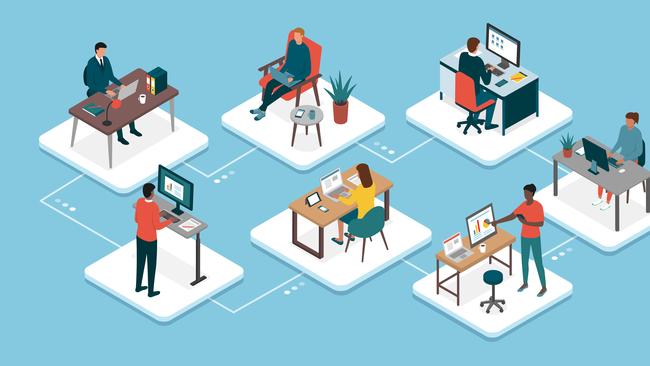From Google down, hybrid work is forcing real changes to the office
Even Google is rethinking its office space as the world heads to a hybrid model of work.

Before COVID-19, predicting the office of the future might have led to thoughts of George Jetson’s space age set-up (complete with flying car), or perhaps some gluten-free biscuits in the office tin.
In the worlds of tech companies, the office has long been less about dreary cubicles and passive aggressive notes about kitchen cleanliness, and more about on-site gyms, basketball courts, tree houses and more free snacks than you could possibly fill your satchel with.
But whether you had a ping pong table in the office or spent your day alternatively sweltering or shivering because the airconditioning was constantly on the fritz, the arrival of a global pandemic has put much of what we think about the office into flux.
For one thing, George Jetson, with his video screen calls, was ahead of the game as many people were forced to “pivot” to working from home.
As HSBC Holdings reported last month, 82 per cent of employees around the world would prefer to work remotely. Luring people back into the office may mean a shift in what the office looks like.
Take Google. The headquarters, in Mountain View, California, is redefining the office. Now it’s less about amenities and well-stocked snack stations and instead reconfiguring what workers might like for a hybrid home-and-office work week. As the New York Times reports, this includes “pod” designs and new meeting setups called “Campfire” — a circular set-up with video screens to accommodate those dialling in.
Miriam Fanning, principal of Melbourne design practice Mim Design, says it has never been more important to consider how people are working when it comes to office design. “There’s now a greater need for workspaces to be designed in a way that is more flexible, enabling the workforce to work within the office itself or from the comfort of their own home,” she says.
“As a result, offices of the future will act as more of a centralised hub for communication, both online and face to face. There will be a need for different zones to accommodate all kinds of work, be it independent, quiet time, collaboration, video or teleconferencing, or even just spaces that allow team members to feel as though they can get away from their desk and clear their mind.
“Fundamentally, the future of the office is one that encompasses flexibility, adaptability, collaboration and, as always, function.”
Fanning believes communal spaces and spaces that engage the senses such as outdoor areas or indoor ones with plenty of fresh air and natural light will make the office more inviting. On the wish list for office workers, she says, are cafe-style kitchens and great office bathrooms with hairdryers and showers so employees can embrace freedoms such as a lunchtime jog, just as they did while working from home during lockdown.
Alex Hopkins, design director at the Melbourne firm Interior Architecture at Studio Tate, says we are witnessing a shift in the purpose of the office.
“Increasingly it is less about independent ‘concentration’ time and more about the opportunity and need for collaboration,” she says. “In a tangible sense this has highlighted the need for fewer single workstations — accommodated with a shared booking system — and the introduction of more informal spaces for collaboration and meetings.”
The “tech piece” around office design, she says, also really needs to be well thought out. This is the case whether it’s room acoustics or good video access.
Yeong Sassall, head of brand at Vogue Living, also believes office design is about to shift. She says there will be a focus on effective collaborative spaces, but also creating inspiring places to work.
“With many of the world’s leading tech companies implementing incredible office layouts to encourage creativity, plus the rise of beautifully designed co-working spaces, everyone is following suit,” she says.
“The importance of greenery, improved waste management, paperless options and outdoor areas will only increase, and hopefully companies will start to see the benefit of creating more attractive offices — especially if they want us to stop working from home.”
Fanning says good design for the office matters, and not just for aesthetics.
“As a studio, we believe office design can greatly influence a positive team culture. It’s not just a space to work in and then go home — it can also foster a culture where everyone enjoys their investment of time in physically coming into the office.”


